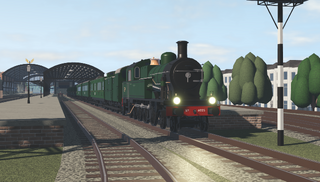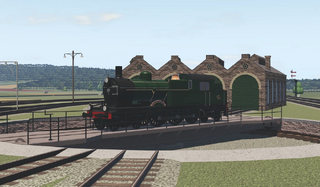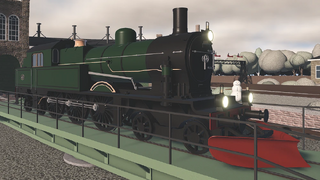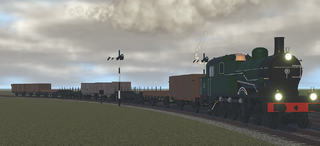| NS 6000 | |
|---|---|
| by Supersnel11 | |
| Price | ƒ154.000 |
| Level | 43 |
| Statistics | |
| Type | Mixed |
| Top Speed | 100 km/h |
| Weight | 93 tons |
| Capacity | 340 tons |
| Passenger Capacity | 2 first class 4 second class |
| Length | 14,6 meters |
The NS 6000 was a series of 26 Dutch 2'C'2t (4-6-4T) mainline engines. The class was intended to be bigger, but some locomotives ended up working for the French railways.
Variants
The NS 6000 is available in two liveries. Both are NS green but the second has extended water tanks. During the winter updates of 2022, it received a snow plough livery.
Historical details
The SS years
After two years of great experiences with their SS 700 (later NS 3700) series, the Maatschappij tot Exploitatie van de Staatsspoorwegen (SS) wanted a tank engine version thereof. 40 locomotives were ordered at Beyer, Peacock & Co. A proper conversion of the design would exceed the maximum permitted axle load of 16 tons, so the tank engine design received a smaller boiler and only two cylinders. These would be the last locomotives Beyer Peacock would make for the Netherlands.
The first locomotives, SS 1201-1203, arrived in September of 1913. Another 23 would arrive throughout the rest of 1913 and up to 1916. The other 14 locomotives, which were ready for shipment, would be seized by the Railway Operating Division (ROD) of the British War Department and sent to the allied armies in France to aid in World War I. This was notable in the numbers of the SS locomotives, which were numbered: 1201-1219, 1223-1225, 1231 & 1238-1240. The English government was so kind as to refund the SS an ample amount of money. As a replacement of the 14 lost locomotives, the Staatsspoorwegen ordered 12 new SS 700s at Werkspoor.
The first services the SS 1200s got were non-stop express trains between Amsterdam and Rotterdam. These were done in an hour, making them 15 minutes faster than the Amsterdam-Rotterdam services of their competitor: the HSM. Their trains did the trip in 75, although they did make an additional stop in Den Haag.
The NS years
When the SS merged with the HSM to form NS, the locomotives were given the consecutive numbers NS 6001-6023.
After WWI, the locomotives were spread around various depots. In 1921 they were stationed at Amersfoort, Rotterdam and Maastricht. The ones stationed at Amersfoort were moved to Hilversum between 1922 and 1932, the Maastricht locomotives went to Rotterdam in 1923, but after Amsterdam-Rotterdam was electrified a part went to Amsterdam and a part to Hoek van Holland. In 1938, the majority was stationed among Alkmaar, Amsterdam and Fijenoord, with a couple in Zutphen and a single one in Zwolle.

During WWII, a couple of the NS 6000s were used for branch line trains on German lines by order of the occupying forces.
After the war ended, 14 out of the 26 machines were missing. Luckily, they were all located in various parts of Germany occupied by the West. Three (NS 6009, 6010 & 6016) were too badly damaged to justify repairs, as were the 6004, 6007 & 6026 which were still within the Dutch borders. The other 20 were put back to work across various depots, but Groningen remained their most important one between 1946-1954, with 14 present at their height there. After the arrival of the 'Blue Angels', as the Dutch called the DE-1, they were spread across many, many depots. Nijmegen depot, for example, had five for a bit, but only three by 1955.
The series was withdrawn between 1953-1957.
The French ones
The 14 locomotives that were sent to France by the ROD were over by the French Chemin de Fer du Nord (or simply Nord) after the war, which numbered the locomotives 3.871 - 3.884 and used them primarily for shuttle services between Paris and Creil. Around 1933, the suburbs of Paris received 1'D'1 (2-8-2) tender locomotives. The ex-ROD locomotives became unneeded and were moved to the depots of Lille and Tourcoing. Here, too, they were used on commuter trains. Nord's personnel gave them the nickname 'Les Hollandaises' (The Dutch).
Despite the great differences with the rest of Nord's rolling stock, they remained in service for a long time, without any major modifications. They did receive a typical Nord smokebox, AFCI pre-heating system, a duplex air pump, electrical lighting and various smaller parts Nord had standardised. The smokestacks were shortened to fit the slightly lower French loading gauge.
When the French railways combined in to the Société nationale des chemins de fer français (SNCF) in 1938, the locomotives were renumbered to 232-TB-1 to 232-TB-14. They got through the Second World War mostly unscathed; only TB-10 was so badly damaged it was written off. After the war they were stationed at seven different depots where they were mostly used for short trains, shuttle services and shunting. TB-3 and -14 were withdrawn first, in 1946. The rest were withdrawn throughout the years, ending with TB-5 in 1954.
Technical details
The NS 6000 were originally equipped with Westinghouse-brakes (automatic and independent), connections for steam heating at the front and back, two injectors, the firebox was secured by both a Ramsbottom-mechanism and a Ashton-mechanism, a Hasler-speedometer, a mechanical Friedmann-lubricator, Gresham & Craven air-powered sanders which only worked on one axle and a Webb-firebox door.
Although these locomotives were designed to be lighter than the SS 700, they shared many similarities. The diameter of the wheels, cylinder stroke length and maximum boiler pressure were the same.
SS 1201-1206 were delivered with smaller water tanks and weighed 91 tons.
In 1918, the locomotives were fitted with a Knorr pre-heater with a heating surface of 9,2 m² and a pump with a capacity of 120 litres a minute. Some of them were removed in 1943 due to high reparation costs and a lack of parts. That same year, the NS 6007-6016 were fitted with an air-powered bell in front of the smokestack so it could drive on German branchlines, albeit from Dutch depots along the border.
Any cylinders that were worn out in the 1930s were replaced with new type of cylinder casting which had straight steam channels. Not all locomotives received this modification. The cylinders on all locomotives were not balanced optimally, which made the axle bearings heat up and wear out quite fast. The valves on the cylinders were not adjustable for the practical reason that, as they were set, the cylinders would be filled with steam for 80% when driving in both directions.
The maximum speed of the locomotives was 90 km/h but this was changed to 100 km/h in 1929.
The cabs of the engines were quite comfortable and could be entirely enclosed with the sliding windows. After the fusion, the driver's place was moved to the right as per Dutch standard.
Trivia
- The NS 6000 is a mid level tank engine suited to passenger runs, with its 4 coach capacity for 2nd class, but also capable of freight runs at considerable speed.
- The NS 6000 is the second engine to be shown on the turntable prior to being released, the first being the NS 8600
- The NS 6000 is the second mixed tank engine in the game, the first being the NS 6200.
- The short water tank variant of the NS 6000 can only get the numbers 6001-6006, with the long water tank variant getting the rest of the numbers.
- This reflects which locomotives had those water tanks in real life.
- The NS 6000 was the first locomotive to have the simple internal valve gear implemented.
- The NS 6000 has been used for trains used in the 2022 and 2023 Halloween quests.
- In version 0.5.12, the NS 6000 received a temporary snowplough livery for the winter season of 2022.
- The snowplough has not returned for any subsequent winter updates.
- The NS 6000 was added in version 0.4.71.
- The Long Watertanks livery was added in 0.7.1.
- It was originally planned to be available during the game's launch.
Gallery
-
NS 6025 in the Voorlem bay platform.
-
6001 on the turntable
-
The 6000 with its plow livery
-
The NS 6000 with an empty Halloween 2022 train.






